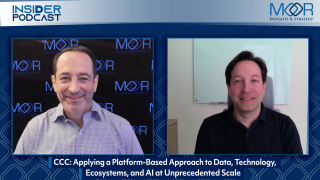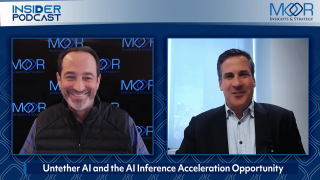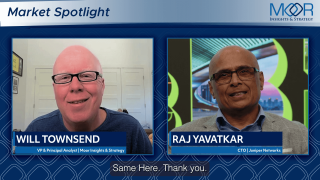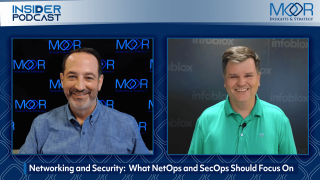On this episode of the Moor Insights & Strategy Insider Podcast, host Patrick Moorhead is joined by Vlad Shmunis, Founder, Chairman and CEO to talk about RingCentral’s 25-year journey.
Their discussion explores:
- RingCentral’s focus on transforming and revolutionizing business communications
- Their approach to AI and its power to augment business communications, drive deeper customer satisfaction and engagement, and enable workforces to reach new heights.
- RingCentral’s unique approach to AI and how it is being infused across the product portfolio.
- Where the communications industry is headed and RingCentral’s vision for the future
Watch the full video here:
Or listen to the podcast here:
Transcript:
Patrick Moorhead: Hi, this is Pat Moorhead back for another Moor Insights and Strategy podcast. So over the years, we have talked about how cloud communications, videos, events, context center solutions have truly become a mission critical app for the enterprise or applications. Just so happens that RingCentral, a leader in these areas, is celebrating its 25th anniversary.
So it’s my pleasure to introduce Vlad, Founder, Chairman, And CEOof RingCentral Vlad. Welcome to the show. You must be a proud papa here. I mean 400,000 customers number one share in UCAS and for those who might not follow That’s universal communications as a service over two billion dollars in revenue last year Just doing great in, in a lot of different areas.
Vlad Shmunis: Thank you. Thank you. It’s been a journey. You’re a little low on the revenue side. It’s closer to three, but who is counting? Yeah, look it’s it’s a bunch of things. Am I proud? Yeah, I think it’s something fun to share with the family over dinner table from time to time. But look it obviously took a village. We were right time, right place quite a bit of luck in all of this, to be clear. But we we were early. We were early in what is now known as UCAS, Unified Communications as a Service via the cloud. We are one of the original cloud or SaaS providers.
We didn’t know that those terms existed as they did not. People did not talk of cloud or software as a service in those days. We just knew that we could deliver a better communications experience by using the internet. And we made it happen. And having said all of that, it’s still very early. We are talking about dramatically changing and improving the ways that folks around the world communicate. In their business interactions that actually involves most of the population off of this planet. Thank you for noting that we do have the leading market share as far as paying customers are concerned. It’s in the six million user range at this point. But contrast that with population of of the Earth. So there is a long ways to go, and fortunately we have the team and the, at this point, the resources and the talent to hopefully make it another 25 years and also make it meaningful.
Patrick Moorhead: Yeah I always think it’s a real treat to talk to Founder, CEOs of companies at scale. I’ve worked directly for a Founder CEO before of a large company. It was quite, quite an experience and just something magical about that. Can you take the viewers back 25 years and maybe talk about how it started and maybe what it’s meant personally to you?
Vlad Shmunis: Yeah, definitely. So, RingCentral happens to be my second company that I founded. The first one was called Ring Zero Systems. And we were also in the communication space. What we had was a smaller phone and fax in those days system running under Windows on PCs. We did pretty well with it. It was a smaller company. I think we picked it around 100 people or so. And we were we were actually number one in the OEM channel. So basically our software was bundled on a number, I would say a majority of business oriented PCs. So desktops in those days, laptops and we had a bunch of channel partners, IBM, HP, Toshiba, Sony.
So, and so forth, come back anyway sold this company to Motorola. This was in 1998 and basically got out with a very clear understanding that there is a better way to help people communicate. In business versus traditional on prem legacy devices. And a bit of a chip on my, and as I found the shoulders saying, “Hey, here’s this new thing called the internet, we’re kind of missing it”. So we came back basically with this idea that. You could deliver a rich communications experience that traditionally was reserved for much larger companies and enterprises. And you can package it in a way and deliver it in a way that would be accessible to the masses.
And my personal background is small business. Starting from literally zero or one or one or two, I think is more proper. In both cases. So something definitely I could personally relate to. And technology was there. Bits were traveling faster, pipes were getting less expensive and more affordable. Early versions of smartphones were coming about. This is pre iPhone, pre Android. But you already had, say, Nextel devices you already were, some of the early Nokia phones were programmable. So you could start doing stuff with mobility. And all of this just led us to believe that look, I mean, right time, right place.
Here is here is the underlying megatrends which is mobility, which is globalization of workforces and proliferation of wideband internet, wideband connectivity. Put it all together, put it with our know how of what businesses needed and wanted. And so we launched.
Patrick Moorhead: Yeah, I love it. Thank you so much for taking me back. By the way, fun fact, I was one of your licensees. I was a product manager at Compaq Computer in the mid nineties till about 99. And yeah, I remember your software. In fact my product was the highest volume, single product sold on the planet. And we sold a lot of our products with your software. So I didn’t know we had that connection until until now. So that’s fun.
Vlad Shmunis: Wonderful. I tell you, we were very clearly reminded. Of the volume opportunity when it came to negotiations.
Patrick Moorhead: I have to go back and see if I remember that.
Vlad Shmunis: That did not go unnoticed.
Patrick Moorhead: Yeah, no, I appreciate that. It’s my apologies. Hopefully that-
Vlad Shmunis: We can solve a good relationship. So-
Patrick Moorhead: Hey, great. Look at. At how you got here, but let’s talk about today. Let’s talk about the business the financial growth product development. Where are we on this map today? Where is RingCentral?
Vlad Shmunis: It sounds super funny, after 25 years, but it’s still early. We’re still early in this journey. Okay. Why is it early? Because it is a very tall mountain to climb. So it just takes some time to get there. Look, you already mentioned some of the numbers. We started out as a pure startup, pure bootstrap. I was the original money behind the company.
And, I had a little bit of money after the Motorola sale, but nothing, too dramatic, let’s say. Okay. So we started out with a nice round number of zero revenues. And we grew to what is now 2.3 billion recurring revenue business. On the financial side we are we’re not growing as fast as we used to. But it’s harder to do once you’re into the billions. What I have to say is that in our space and vis a vis our competitors and other folks in our space we are still outgrowing them all. Okay, and I’m going to leave some of the names to your imagination, but let’s say from the public companies, we’re the only ones really growing, and from the private companies, many of them are a little too little, too late to the game.
So, we feel that we are pretty well positioned. Look, it’s competitive. It’s a service and a collection of capabilities that are needed by the masses. So you have to expect competition. Okay. And it’s not a natural monopoly, but we expect to be one of the survivors for years and decades and decades to come. And as I mentioned look with our, you mentioned 400,000 accounts, it’s a million users. So that’s all great, but overall opportunity is 10 to 20 times that we feel. And there are a number of ways to get to market sizing and they all suggest that that would be about the right range, what I’m mentioning. And even though we’re in the lead, there is huge amount of greenfield still left and we’re here to get as much of it as we can.
Patrick Moorhead: Yeah, I, we agree that there’s a lot more to do. I feel like some of the punditry maybe two years ago was about we have arrived. But here’s the thing, until we can have communications that are more lifelike when you want it to be lifelike, not everybody wants to see you in perfect 4k and see every one of your moves. But what really got this going was the integration of data. And how you can intersperse data into this and not only on the UCAS side, but on the call center in particular is one of the most dissatisfying experiences to consumers, right? So there’s so much we can do there. And not that. AI is new, right?
First AI algorithms created in the sixties. We saw a little bit of AI using more data analytics. And then about 15 years ago with machine learning and then deep learning. And here we are with generative AI. That again, AI isn’t new, but generative AI does represent a next new step to improve experiences and monetize it. And it seems like something that customers are willing to pay more for. So, RingCentral has embraced AI wholeheartedly. Can you talk to our viewers about how you’ve integrated, what’s your strategy? For integrating AI even more and how’s it different from your competitors?
Vlad Shmunis: Yeah look 60s is a little bit before my time I have to say, but my master thesis which was in the 80s It did have to do with AI and the programming language Lisp, which was the primary vehicle for that. So I have a little bit of familiarity. Certainly nothing that would make me an AI expert, these days. But look, I’m on the record of calling AI the mother of all megatrends. Just like the original megatrends of mobility, workforce, globalization, and broadband, made the RingCentral 1.0 happen.
Now there is a new wave, and it’s a, really a much more profound wave, which is generative AI. Look Firstly, it is super early for AI. It has great promise as well as many issues. Some of these issues are technical advertised hallucination phenomena, okay? Which is serious, okay? Because if you try to use AI for example, for customer interactions, and if you ask it a technical question, and you get a hallucinated answer, that is probably not a good outcome.
Patrick Moorhead: Yeah, in fact we saw a major airline who was using a contact center and the airline agreed to do something and it was a mistake. And then the airline got sued by the consumer and the court ruled that the airline needed to abide by the commitment that the AI bot with no human said it. So yes, absolutely. We were, we’re seeing the good, bad and the ugly.
Vlad Shmunis: Yeah. I am 99.99. It’s never a hundred percent. We at RingCentral we are five to six nines, so I’ll leave it as that, but I’m call it five nines. Confident that these things these types of teasing pains will be resolved in a relatively short period of time. Okay, I think we’re not talking months, but I think we’re talking short years here. Look, there are obviously other issues which we don’t need to get into here, but there are, I think, social issues, there are political issues which are well understood, okay?
Having said that, what does it mean for us? Look, it’s a new tool, okay? As any tool, it can be used or it could be misused. So, and there are growing pains. And nobody is immune, when you’re learning to use a new tool, sometimes you hit your finger or something, but having said that I tell you where immediate applications that we see for for our users and our industry. Okay, so, we’re talking about Enhancing person to person communications or one to many or many to many communications. And we are thinking in terms of doing it in a modality neutral manner.
You made the comment that maybe not everyone wants to see every wrinkle on our clothes. Maybe some don’t. But one point I do want to get out is that there has been a lot of hoopla and rightfully so about proliferation of video and proliferation of digital means of interaction. But vast majority of human interactions to this day are still by voice. Okay? And there are definitely cases and perhaps this, particular interaction we’re having is a good case for video.
But if you are calling your plumber, because you have a gas leak or something, they don’t need to see your face or vice versa. You just need to call them from the car and it’s probably not a good idea to talk into your phone with your camera on when you’re driving. This is just one simple use case. So voice is here to stay video is also here to stay, other modalities are here to stay as well. All of them can be enhanced with AI in a very meaningful manner. Some of the some of the implications and enhancements that we’re working on have to do with call transcription, call translation call summarization.
When I say call, it could be a voice call, it could be a video call, it could be a digital transaction for that matter. We are about to introduce some major AL lead enhancements to our flagship cloud PBX product that by the time this interview errors, the world will know it it as RingEX. Currently we call it MVP, message, video, phone. Okay, to become a RingEX. Why is it going to RingyEX? Because it’s more about just connecting people, which is what message, video, and phone is. It’s really about employee experience, which is absolutely going to be AI enhanced and AI assisted. So I just gave you some of the examples of immediate applications of AI.
There is much more to do. And some even deeper possibilities having to do with quality enhancement with predictability, with routing, call routing and predictability. Okay, and very importantly with information at your fingertips assistance. Okay, so when we are having a call like this is a form of a call, and you ask me, for example, about what happened 25 years ago I happen to remember a few things. I’m sure there are many things I forget. What if I had a side screen? We said 25 years ago, You did this and that, and what happened if on your side, you had a little helper saying as a matter of fact, back then, Compaq was able to get this price Ring Zero, which blew all kinds of other most favorite nation closes in other countries.
Okay. But you understand where I’m going with this. I’m trying to keep it light, but information at your fingertips and information processing and making Conversation content actionable and discoverable. I think that’s where we’re going with this.
Patrick Moorhead: No, this is great. And, wisdom and experience matters in business and it matters in tech and not that the past is the, is always going to predict the future, but there are pathways and similarities that you can look at about what drives market and what drives user experience. And I call it the magic of interspersing tech technology with the art of the science with what could be, and it truly is an art.
And you were. At the forefront of early business communications related to the PC with voice faxing things like that you led the industry and I think it dare to say you really founded this new industry of What is now called UCAS. I have to ask what comes next? You talked a little bit about the experience but can you put a maybe a finer point? On maybe some predictions about the future. Where are we from an experiential basis for an industry basis?
Vlad Shmunis: Yeah , look, I’m not a futurist, and-
Patrick Moorhead: You actually create real products. Okay, and by the way futurists 99 95 times out of 100 had been wrong-
Vlad Shmunis: It depends on the time scale. I could debate that. What was wrong a hundred years ago is maybe becoming more of a reality in the next hundred years. But look you say it’s an art form it is, but there is some science to it too. I tell you how we approach this for what it’s worth. Look, we have a large team, a talented team, certainly the best we can get and retain, and there are lots of smart people, thinking day in and day out as to what the future might look like. Having said that, we are, but a pebble in the sea, compared to the mass of our customers, right? We have 6, 000 people versus six million users of the platform and these are paying users, right? So these are, this does not count all of the contacts and callers video or otherwise or voice that are in contact with that.
So the way that this company has always evolved is by having our ear very close to the ground and hearing what the users say, okay? Because we may have all kinds of ideas and sounds. wonderful in a meeting room or in a whiteboard and then people just don’t get it, don’t like it, there is something else, so you also have to have a little bit of humility in pushing your vision on the larger, population. Okay look, having said all of that nobody has outlawed Moore’s law yet, it’s going to probably continue for some time. Communications is going to become better It’s going to become better quality wise. Okay, it’s going to become better reliability wise and you already mentioned this Patrick.
It’s going to become meaningfully better vis a vis data enrichment and data retention and data leveraging. So, again I don’t believe that AI and 5G and Starlink for that matter, they all play together, that it’s not going to change the fundamental way in which people communicate. At least I hope it does not, okay? But it will make our interactions richer. It will make our interactions fundamentally more productive. I think it will have what is in some ways unfortunate, but I think inevitable effect of making some of the more manual jobs. Less in demand, you do not need, for example, a note taker the system takes notes for you, case, simple case in point.
You may not need as many agents in the contact center. If you can have an I V A, Interactual virtual agent or assistant taking care of some and at some point in time, maybe majority of your customer requests. Okay, so this is some of the, I think more, more obvious examples. Again, look, it’s going to be pervasive but I would think that, let’s say if we had this interview even ten years ago you wouldn’t have a Streamyard. Wouldn’t exist. You wouldn’t be asking me these questions about AI and and we wouldn’t be, talking about co-pilots, right? Like this notions didn’t even exist, or maybe they existed somewhere in the, MIT lab or something. So all of this is really getting democratized. I think it’s good, personally, okay? And I think, look, in the end, it’s part of progress. It’s just going to make, hopefully, our lives a little bit more more fulfilling and and will engender yet more innovation.
Patrick Moorhead: Yeah, I think we’re aligned on this. You’re a tech optimist. You’re also a pragmatist that and it’s the toughest end customers and users on the whole. Aren’t very comfortable with rapid change, right? So they need to have some sort of a link to the past use case to get them to the next level. And I, the iPhone was 10. More years after the first smartphone was invented, people needed time on a smartphone before they were ready for multiple apps and an app store. I think that’s an example. I like the idea of co pilots. Nobody owns the word co pilot, but there’s the co pilot and there’s the pilot. The pilot is going to be the end user and the co pilot. In any form, whether it’s in UCAS, CCAS will be its helper. And those examples that you used are very close.
And in fact many of them will be delivered in your next product that you will have announced by the time this airs. So I appreciate your optim optimism and pragmatism. So you heard it here 25 year RingCentral journey state of the current business, AI, the company’s approach vision for the future, Vlad, I really appreciate time with you and I hope we get time to chat again in the near future.
Vlad Shmunis: Thank you. Thank you, Patrick. Absolute pleasure to be continued. Hopefully. And wish us luck. We need that.
Patrick Moorhead: I don’t know. You’ve done pretty good, but I’ll wish you luck and everything in the future. Thank you. So this is Pat Moorhead with more insights and strategy. Thanks for tuning into the podcast. Checking out all of our RingCentral content, UCAS, CCAS video text, everything we have on our website. If you, Liked what you heard? Hit that subscribe button. Take care. God bless.




















































































